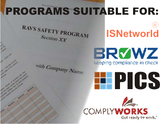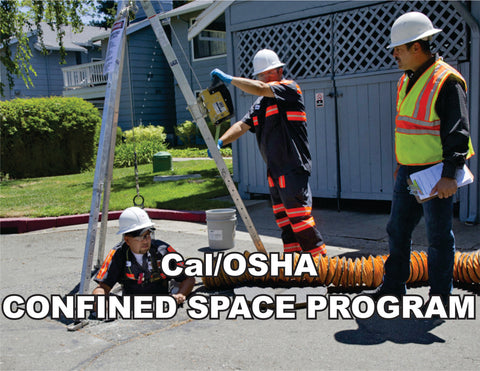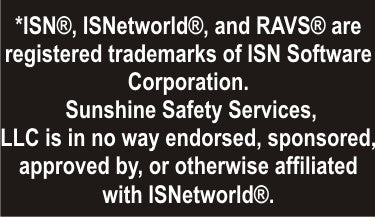Cal/OSHA Confined Space Program - ISNetworld RAVS Section - US
$ 34.95
Cal/OSHA Confined Space Program - ISNetworld RAVS Section - US

This Cal/OSHA Confined Space Program (ISNetworld® RAVS®* Section), in addition to being a complete and functioning written safety program (chapter), it also contains all the required text elements that are sought by the ISNetworld RAVS® (Review And Verification Service) reviewer. This plan has been previously submitted and has achieved a 100% approval rating for our clients.
- All programs are guaranteed now and in the future to achieve 100% approval.
- There are NO maintenance or subscription fees.
- Simply notify us if any program falls out of compliance and we will correct it at NO CHARGE.
You are downloading a MicroSoft® Word document file to your computer that is completely editable:
- Cal/OSHA Confined Space Program:
- Approximate Word Count: 7,450
- Approximate Number of Pages: 17
- Page Reference Answers to RAVS Reviewer’s Questions: 9
You will also receive instructions for a simple two-step process to place your company name and safety person's name throughout this word document to conform it to your company. Please review, and feel free to alter or add to it as you wish with any specific company information or safety policies that you may already have.
The first two pages of the document are guidelines for conforming this safety manual section, an index for completing the RAVS® questionnaire (with all page references), and uploading the section.
If you experience any difficulty filling out the questionnaire, or have any questions in general about these documents, call 314-570-0072, or e-mail me at vsunshine1@gmail.com.
An excerpt from ISNetworld® RAVS®* Safety plan Cal/OSHA Confined Space Program
INTRODUCTION
The hazards that may be present in a confined space are not easily seen, smelled, heard or felt, but can represent deadly risks. The worker who enters confined spaces may be, or often is, exposed to multiple hazards due primarily to ignorance or negligence in the enforcement of safety regulations. This ignorance and neglect has led to countless deaths by asphyxiation, fire and/or explosion, and by fatal exposure to toxic materials.
A permit-required confined space is one in which dangerous air contaminants may be generated and may not be removed by ventilation. When an employee works in this type of environment, the chance exists that atmospheres present may be oxygen deficient, combustible or toxic. Prevention of injuries to the life and health of workers requires that they be properly trained and well equipped to recognize, understand and control the hazards they could encounter. In the process of identifying a confined space, the supervisor in charge should always assume that a hazard is present.
RESPONSIBILITIES/ DUTIES
For each confined space entry, the RSO, Replace with Safety Person’s Name will appoint an Entry Supervisor who will have the following duties:
1. Appoint an individual to serve as an authorized individual to perform the required monitoring and to issue entry permits.
2. Assure that the authorized individual(s) (i.e. authorized entrants and attendants) receive all the necessary training to effectively discharge their duties. This shall be by review of training records with the RSO and interviews with the assigned personnel. All training shall occur before the individuals are assigned.
3. Assure that all individuals who enter confined spaces receive the required training.
4. Assure that all necessary equipment and supplies to effectively protect the health and safety of the workers are provided and maintained in a good state of repair.
5. Develop departmental policies that will assure that all confined space entries are performed in compliance with this written program and all applicable regulations.
6. Develop departmental policies that will assure that all required records are maintained.
7. Department heads, or designated agents, shall be responsible for ensuring that the confined spaces under their control have been posted.
8. Develop procedures for coordinating entry operations for multi-employer's so that employees of one employer do not endanger the employees of any other employer, such as:
a. Apprise all other employers’ employees who will enter the confined space of known and/ or expected hazards in the area, along with countermeasures to be taken upon entry.
b. Apprise all other employers’ employees who will enter the confined space of what constitutes prohibited conditions in the area which requires immediate evacuation.
c. Ensure the attendant(s) keeps an accurate, contemporaneous written count of employees from each employers who are present in the confined space at any time.





